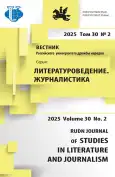Адаптация телевизионных видеосюжетов в социальных медиа: выразительные средства и тематика
- Авторы: Чобанян К.В.1
-
Учреждения:
- Московский государственный университет имени М.В. Ломоносова
- Выпуск: Том 30, № 2 (2025)
- Страницы: 361-375
- Раздел: Журналистика
- URL: https://journal-vniispk.ru/2312-9220/article/view/319134
- DOI: https://doi.org/10.22363/2312-9220-2025-30-2-361-375
- EDN: https://elibrary.ru/JYAWQG
- ID: 319134
Цитировать
Полный текст
Аннотация
Проанализированы адаптированные новостные видеосюжеты информационных телеканалов на платформе VK. К адаптированным видеосюжетам мы относим титрованные новостные материалы без закадровой начитки, использующие видеоряд в качестве основного элемента и удовлетворяющие запрос аудитории на информативный просмотр без звука. В выборку вошли материалы телеканалов «Россия 24», «360°» и «Москва 24», охватывающие две типовые недели в апреле и в сентябре 2024 г. Основной метод исследования - количественный контент-анализ. Экранный язык адаптированных видеосюжетов впервые подробно рассмотрен через четыре группы изобразительно-выразительных средств: драматургические, пластические, аудиальные и монтажные. Выявлена единая для федерального, регионального и муниципального уровня тематика сюжетов (медицина и здоровье), также обозначена специфика в тематических преференциях каждого канала. Рассмотрены рамки хронометража и набор визуальных и аудиальных элементов в арсенале производителей. Анализ экранного языка адаптированных видеосюжетов позволил сделать выводы об использовании титров в качестве одного из основных элементов построения драматургии и о трансформации аудиальных средств для адаптации под цифровые платформы. Только 40 % видеосюжетов используют эмоциональный компонент в начале и в финальном эпизоде. Обозначены направления дальнейших исследований.
Об авторах
Каринэ Вардановна Чобанян
Московский государственный университет имени М.В. Ломоносова
Автор, ответственный за переписку.
Email: chobanyankv@my.msu.ru
ORCID iD: 0000-0002-7793-5010
SPIN-код: 8106-5720
кандидат филологических наук, доцент кафедры телевидения и радиовещания, факультет журналистики
Российская Федерация, 125009, Москва, ул. Моховая, д. 9, стр. 1Список литературы
- Argila, J. (2017). How to create video news that rocks in social media. https://reutersinstitute.politics.ox.ac.uk/our-research/how-create-video-news-rocks-social-media
- Bulayeva, M.N. (2021). Transmedia Storytelling Techniques in the Coverage of Socially Important Issues (Case Study First Regional Media Holding). Bulletin of the South Ural State University. Series Social Sciences and the Humanities, 21(4), 92–99. (In Russ.)
- Bock, M.A., Assaf, C.T., Richardson, R.J., & Tsyrenzhapova, D. (2023). Narrative authority in online video: Legacy media and digital native production styles. New Media & Society, 0(0). https://doi.org/10.1177/14614448231215483
- Bock, M.A., Richardson, R.J., Assaf, C.T., & Tsyrenzhapova, D. (2023). Improvisation, Economy, and MTV Moves: Online News and Video Production Style. Electronic News, 17(3), 146–163. https://doi.org/10.1177/19312431231157104
- Chobanyan, K.V. (2025). Genres and forms of television news videos in VK and Telegram social networks. Journalism in 2024: creativity, profession, industry: Proceedings of the international scientific and practical conference (pp. 207–208). Moscow State University Publ. (In Russ.)
- Chobanyan, K. (2020). Up for the challenge? Digital Practices of 24-hour News Channels. World of Media. Journal of Russian Media and Journalism Studies, (3), 35–56. http://worldofmedia.ru/volumes/2020/2020_Issue_3/World%20of%20Media_3-2020%20(1)-35-56.pdf
- Chobanyan, K., & Nikolskaya, E. (2021). Testing the water: TikTok’s potential for television news. World of Media. Journal of Russian Media and Journalism Studies, 3(3), 62–88. http://worldofmedia.ru/volumes/2021/2021_Issue_3/World%20of%20Media_3-2021-62-88.pdf
- Kalogeropoulos, A., Cherubini, F., & Newman, N. (2016). The Future of Online News Videos. Digital News Project 2016. https://reutersinstitute.politics.ox.ac.uk/our-research/future-online-news-video
- Kruglova, L.A., Chobanyan, K.V., & Shchepilova, G.G. (2020). Online video: structure, content, monetization. Moscow: Aspect Press Publ. (In Russ.)
- Kruglova, L.A., & Shchepilova, G.G. (2024). Russian TV channels and social media in the transformation of the media field. Tomsk State University Journal of Philology, (87), 255–272. (In Russ.) https://doi.org/10.17223/19986645/87/14
- Lushchikov, V.A., & Terskikh, M.V. (2018). Video blogging genre, thematical and linguistic properties. Tambov University Review. Series: Social sciences, 4(14), 58–59. (In Russ.)
- Proskurnova, E.L., Zhu, W., & Volkova, I.I. (2023). Experience of posting news in the format of short videos by Chinese TV channels on Douyin. The Art and Science of Television, 19(4), 233–269. (In Russ.) https://doi.org/10.30628/1994-9529-2023-19.4-233-269
- Shatskaya, A.D., & Makeenko, M.I. (2022). Television content in the new media: the work of television channels with the broadcast content in the Internet: monography. Moscow: Aspect Press Publ. (In Russ.)
- Shesterina, A.M. (2018). Transformation of audial and visual content in the web environment: virtues of the context analysis. ZNAK: problemnoe pole mediaobrazovanija, (2), 86–95. (In Russ.)
- Volkova, I.I. (2019). TV channels on YouTube: reasons for inefficiency. Journalism in 2018: creativity, profession, industry: Proceedings of the international scientific and practical conference (pp. 468–469). Moscow State University Publ. (In Russ.)
- Weller, D. (2023). Toward a Taxonomy of News Video. Journalism & Mass Communication Educator, 78(1), 53–68. https://doi.org/10.1177/10776958221139898
Дополнительные файлы









